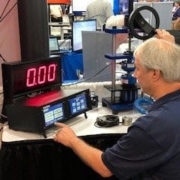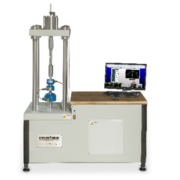Do You Call it a Thru-hole, Donut, or Load Washer?
 In the world of test and measurement, one load cell model that seems to garner a series of names is the thru-hole load cell. Is it a through-hole, thru-hole, donut, load washer, or force washer load cell?
In the world of test and measurement, one load cell model that seems to garner a series of names is the thru-hole load cell. Is it a through-hole, thru-hole, donut, load washer, or force washer load cell?
The answer is all the above. Though the names may differ, the basic middle hole design feature is the same. These sensor model terms refer to the same cylindrical shape with a central hole. Regarding function, these load cells measure the force acting on an object through its center using strain gages to convert force into an electrical signal for measurement.
The difference is in size, capacity, and how you use the thru-hole sensor. Are you using it to measure force, weight, torque, or a combination of measurements using a thru-hole multi-axis sensor? What dimensions will fit your use case? What range of measurement capacity do you require for your application? Are you conducting single tests in a lab or integrating the sensor into an existing testing stand or product?
Thru-hole sensors are versatile, accurate, and compact solutions for various applications, making them a valuable tool for engineers and technicians. They offer high-precision measurements, ensuring reliable data collection for quality control and performance monitoring tasks. The compact size allows space-saving installation even in tight areas, making them ideal for applications with limited footprints, like robotic systems or custom machinery.
Diversity of Applications Using Thru-Hole Precision Sensors
Aerospace and Aviation: Thru-hole load cells are critical in aerospace and aviation applications for testing the structural integrity of aircraft components, such as wings, fuselage, and landing gear. They are also used in flight simulators for training purposes. Check out how our load washer load cell is used in a spacecraft test: Satellite Deployment.
- Compression Testing: Thru-hole load cells are widely used in compression testing applications where forces must be accurately measured. This includes material testing, structural testing, and component testing.
- Robotics: Thru-hole load cells are utilized in robotics applications for force sensing and control. They can be integrated into robotic arms and grippers to measure forces exerted during manipulation tasks, assembly processes, and material handling operations.
Automotive Testing: In the automotive industry, thru-hole load cells are employed for various testing purposes, including crash testing, durability testing, and component testing. They can measure forces exerted on vehicle components, such as suspension systems, brakes, and steering mechanisms. See: Brake Caliper Testing
- Medical Device Testing: In medical device manufacturing, thru-hole load cells are utilized for testing the performance and durability of medical equipment, such as prosthetic limbs, orthopedic implants, and surgical instruments.
- Material Handling Equipment: Thru-hole load cells are integrated into material handling equipment, such as cranes, hoists, and lifts, to monitor and control lifting forces. They ensure safe and efficient material handling operations in the construction, manufacturing, and logistics industries.
- Geotechnical and Civil Engineering: Thru-hole load cells are used in geotechnical and civil engineering applications for soil and rock testing, pile load testing, and structural monitoring. They provide valuable data for assessing the stability and integrity of foundations, retaining walls, and other structures.
Industrial Automation: Thru-hole load cells are essential for process control, quality assurance, and safety monitoring in industrial automation systems. They are integrated into machinery and equipment to measure forces and torque during manufacturing, assembly, and material processing. Check out this thru-hole torque application: Chemical Reaction-Mixing
- Measuring bolt tension: Thru-hole load cells can measure the force applied to a bolt to ensure it is properly tightened. This is important in applications where a loose bolt could lead to a safety hazard or equipment failure. See: Bolt Tension Monitoring
- Monitoring press forces: Thru-hole load cells can be used to monitor the force applied by a press to ensure that it does not exceed the capacity of the press or damage the material being pressed.
- Weighing systems: Thru-hole load cells can be used in weighing systems to measure the weight of an object. They can be used in various applications, such as conveyor belts and truck and tank scales.
Interface Thru-Hole Load Washer Load Cells
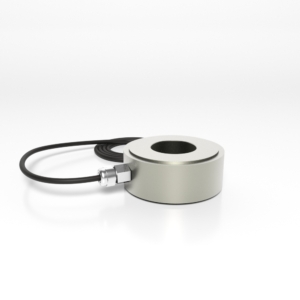 The Interface Load Washer Load Cells are donut-shaped sensors using advanced strain gage technology to measure compressive forces precisely.
The Interface Load Washer Load Cells are donut-shaped sensors using advanced strain gage technology to measure compressive forces precisely.
Their center-hole design makes them ideal for scenarios involving bolts, fasteners, and clamping applications and for environments with minimal space. The thru-hole load washer load cells are relatively easy to install, especially in applications that need integration into existing systems or structures. Their design allows for straightforward mounting and connection.
We offer eight distinct load washer model series in various capacities for each. Our load washers boast capacities ranging from a delicate five lbf to a mighty 1,124K lbf, catering to a broad spectrum of force measurement needs.
LW GENERAL PURPOSE LOAD WASHER LOAD CELL 5 lbf to 40K lbf
LWCF CLAMPING FORCE LOAD CELL 3.37K lbf to 33.7K lbf
LWHP14 PRECISION LOAD WASHER LOAD CELL 11.2 to 22.5K lbf
LWHP18 HIGH CAPACITY PRECISION LOAD WASHER LOAD CELL 1.12K lbf to 1,124K lbf
LWMH1 LOAD WASHER LOAD CELL WITH MOUNTING HOLES 45 to 2.25K lbf
LWMH2 LARGER LOAD WASHER LOAD CELL WITH MOUNTING HOLES 112.4 to 4.5K lbf
LWPF1 PRESS FORCE LOAD WASHER LOAD CELL 450 to 22.5K lbf
LWPF2 HIGH CAPACITY PRESS FORCE LOAD WASHER LOAD CELL 22.5K to 135K lbf
Their typical small size and donut shape make them easy to integrate into tight spaces and various configurations. Note that Interface also offers larger sizes for larger applications, like the LWPF2, which is over 12 ½” in diameter. They offer precise force measurement for critical applications demanding tight tolerances. These load cells are built to withstand demanding environments and handle repeated loading cycles.
Interface Thru-Hole Torque Transducers
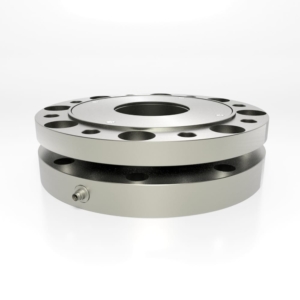 The central hole torque transducer allows easy integration into existing testing environments, structures, and machinery, making them adaptable to various torque measurement applications. These devices are popular for measuring tool performance in different testing labs.
The central hole torque transducer allows easy integration into existing testing environments, structures, and machinery, making them adaptable to various torque measurement applications. These devices are popular for measuring tool performance in different testing labs.
TSCF C-FACE FLANGE TORQUE TRANSDUCER 88.5 lbf-in to 885 lbf-in (10 Nm to 100 Nm)
T27 BEARINGLESS HOLLOW FLANGE STYLE ROTARY TORQUE TRANSDUCER 443 lbf-in to 8.85K lbf-in (50 Nm to 1000 Nm)
TS11 Flange Style Reaction Torque Transducer 88.5 lbf-in to 177K lbf-in (10 Nm to 20K Nm)
TS19 SHORT FLANGE STYLE REACTION TORQUE TRANSDUCER 443 lbf-in to 88.5K lbf-in (50 Nm to 10K Nm)
TS20 Hollow Flange Style Reaction Torque Transducer 88.5 lbf-in to 1.77K lbf-in (10 Nm to 200 Nm)
5330 Hollow Flange Style Reaction Torque Transducer
Overall, the thru-hole design enhances its versatility and applicability across various industries and applications where precise measurement is essential for performance, safety, and quality assurance.
Interface Thru-Hole Multi-Axis Sensor
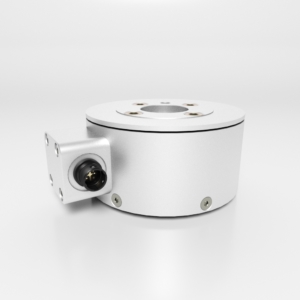 As with all sensor technologies today, the more data, the better for some applications. In addition to the capabilities to measure Fx (N), Fy (N), Fz (N), Mx (Nm), My (Nm), Mz (Nm) in a 6-Axis Multi-Axis Sensor, Interface does offer a thru-hole model.
As with all sensor technologies today, the more data, the better for some applications. In addition to the capabilities to measure Fx (N), Fy (N), Fz (N), Mx (Nm), My (Nm), Mz (Nm) in a 6-Axis Multi-Axis Sensor, Interface does offer a thru-hole model.
6ADF Series 6-Axis DIN Flange-Type Load Cells Force: 4.5 to 269 lbf, Torque: 8.85 to 531 lb-in (Force: 20 N to 1.2 kN, Torque: 1 Nm to 60 Nm)
Interface’s 6-axis load cell measures forces simultaneously in three mutually perpendicular axes and three simultaneous torques about those same axes. Six full bridges provide mV/V output on six independent channels. Interface’s 6-axis load cell is ideally suited to many industrial and scientific applications, such as aerospace, robotics, automotive, and medical research (orthopedics and biomechanical). A 36-term coefficient matrix is included for calculating the load and torque values in each axis. An 8-channel amplifier with USB PC interface is also available, which simplifies data analysis.
For your convenience, detailed specifications, design files, and model ranges are readily available online. Use our Interface Load Cell Selection Guide to evaluate force measurement sensors. Use our Interface Torque Selection Guide to find a torque measurement transducer with a thru-hole design best suited for your next testing project.
ADDITIONAL RESOURCES
Interface 2023 Top Products and Trends
Interface Mini Load Cells Growing in Product Use and Testing

